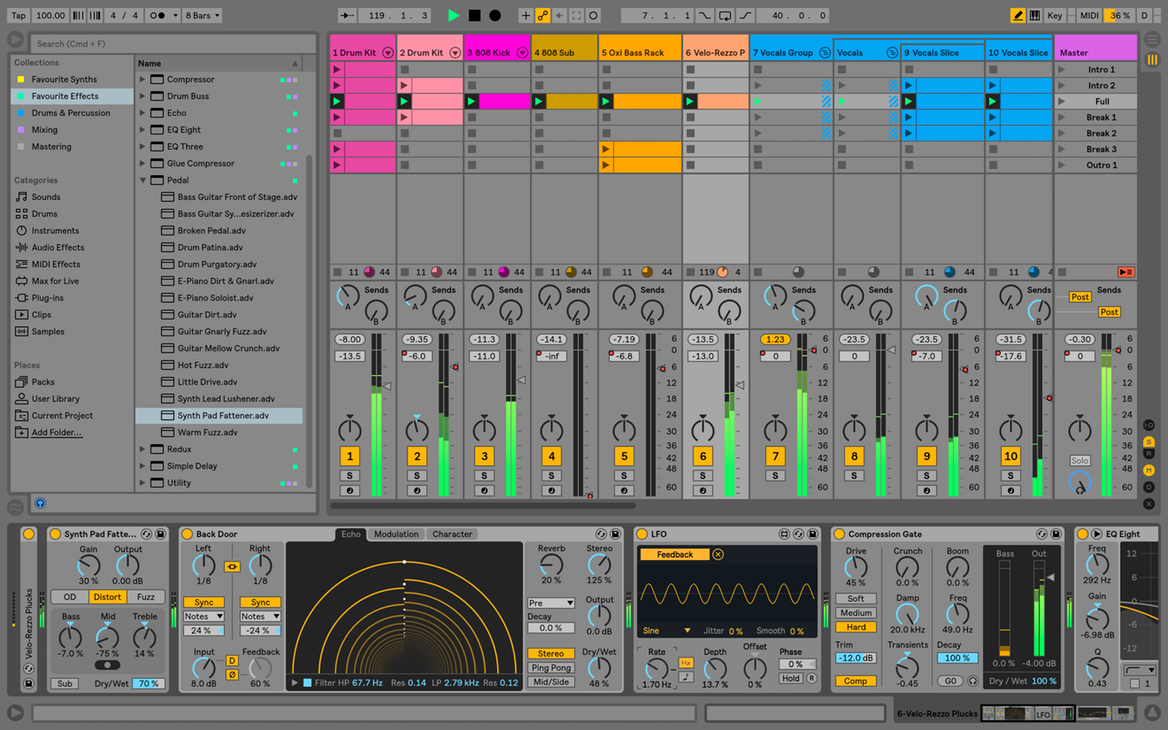

Although a bit dated by today’s full colour LCD standards, the four line display still provides useful text and graphical feedback when using Push’s knobs and buttons. You can change their behaviour simply by selecting the parameters on the bank of buttons to the right of the LCD, including Volume, Pan & Send and Track focus. The rotary knobs above the LCD screen control a variety of parameters in Live depending on what you set it it on. The column of buttons to the right of the grid launch Scenes, which is what Live calls a row of clips in your session. In useįor folk who just want to get started using a hardware controller without all the extra mapping effort, Push offers an elegant solution as it’s tightly integrated with Live 9. At its most basic, the 8×8 pad grid lets you launch clips in Session view, and the two rows above it allow you to arm and enable/disable a track.
#ABLETON LIVE LITE 9 UPGRADE#
It does come with a copy of Live 9 Intro and upgrade paths to Live 9 Suite, but what you’re basically paying for is what this thing can do to enhance your workflow. Also note the absence of standard 5-pin Midi ins and outs.Įverything here quietly screams quality, and this alone seems to make the US$599 retail tag a little easier to swallow despite the unit not having an onboard audio interface. You can use the Push with a single USB cable, but we recommend plugging in the included power supply to fully appreciate its aesthetic. There are no Midi outputs, but there are two inputs for footswitches and sustain pedals. Using Push via USB alone is fine for dimly lit environments, but the device looks fantastic when plugged in properly, as button labels are fully illuminated and all the pads just seem to jump out more. Numerous buttons surround the grid layout that appear blank when the unit is powered off, but plugging Push in via USB or the included power supply reveals their markings. There’s a 17cm touchstrip to the left of the pad grid that you can use for scrolling within your Live session or for pitch bends when playing a synth, and are 11 endless rotary touch-sensitive knobs that display information on the four-line Push LCD when you rest a finger on them. There are 64 velocity and sensitive pads that can transmit a range of commands to Ableton Live (eg a soft pianissimo snare hit to a loud fortissimo strike). Push’s 64 velocity-sensitive pads are chunky and built to withstand daily abuse by heavy-handed producers. With an aluminium base and the rest made of a rubbery material, the device at rest looks like a sculpture more than a piece of production kit. Weighing in at a hefty 6.6 pounds and measuring almost 12″x 15″, this isn’t a cheap plastic controller that slides off your desk. So what makes Push different? What exactly separates it from all the other controllers out there? Let’s find out. They are still very popular controllers for both live performance situations and studio use today (and the APC40 has just been relaunched), and so are the controllers built by the manufacturers we mentioned previously (Launchpad, OHM RGB and Monome 64/128, respectively). The predecessors of Push, the APC40 and APC20 are Ableton workhorses that were developed in an exclusive partnership with Akai.

#ABLETON LIVE LITE 9 SOFTWARE#
While companies like Novation, Livid Instruments and Monome created USB/Midi devices that let users take control of it, none had offered a tight, one-to-one integration with the software that required minimal tweaking and mapping – until the Akai APC40 and APC20 came out, that is. Whether as the centrepiece of an Ableton Live music production studio or onstage as a controller for performance, triggering clips and improvisation, Ableton clearly markets Push as a complete hands-on solution for what is arguably electronic music’s most ubiquitous DAW today.Įver since Ableton Live came out, third-party manufacturers have churned out a variety of controllers that take advantage of Live’s unique workflow, but only a handful specifically address its Session view, which is the heart of the Ableton Live experience. The Ableton Push is a USB hardware controller designed for seamless integration with Ableton Live 9.

With all the controllers that have gone before it, none have been as ambitious or as complex while retaining Live’s fun factor. The Ableton Push controller is currently the only controller that gets you this deep and decidedly intimate with Live 9.


 0 kommentar(er)
0 kommentar(er)
